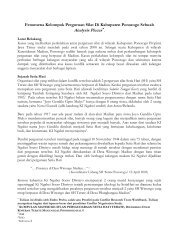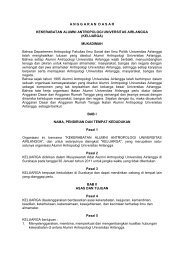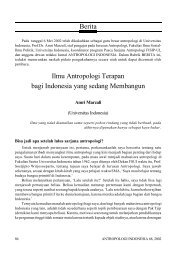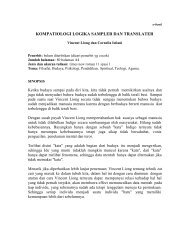The Future of Visual Anthropology: Engaging the Senses
The Future of Visual Anthropology: Engaging the Senses
The Future of Visual Anthropology: Engaging the Senses
Create successful ePaper yourself
Turn your PDF publications into a flip-book with our unique Google optimized e-Paper software.
widijanto judono e-Library collection - widijanto.wordpress.com<br />
analysis <strong>of</strong> precisely what it refers to. In this book I ask how, in <strong>the</strong> light <strong>of</strong> recent<br />
anthropological work on experience, <strong>the</strong> senses and phenomenology, we might<br />
research and represent aspects <strong>of</strong> o<strong>the</strong>r people’s experience in ways that are meaningful<br />
to o<strong>the</strong>rs and what <strong>the</strong> role <strong>of</strong> <strong>the</strong> visual might be in this practice. In chapters<br />
3 and 4 I discuss how we might understand on <strong>the</strong> one hand <strong>the</strong> visual research and<br />
representation <strong>of</strong> experience, and on <strong>the</strong> o<strong>the</strong>r <strong>the</strong> experience <strong>of</strong> visual representation.<br />
To do this I draw from recent work developed in <strong>the</strong> anthropology <strong>of</strong> <strong>the</strong><br />
senses, which is instructive for two reasons. First, following o<strong>the</strong>r recent work on<br />
<strong>the</strong> senses and my own visual ethnography <strong>of</strong> <strong>the</strong> home, I see <strong>the</strong> relationship<br />
between <strong>the</strong> visual and <strong>the</strong> o<strong>the</strong>r senses as key to understanding how everyday<br />
experiences and identities are constituted (Pink 2004a). Second, because <strong>the</strong><br />
anthropology <strong>of</strong> <strong>the</strong> senses encompasses vision, it locates it in relation to o<strong>the</strong>r<br />
sensory modalities. As such it challenges <strong>the</strong> privileged status that vision is lent by<br />
visual anthropology, and demands we rethink <strong>the</strong> ideas <strong>of</strong> visual knowledge, experience<br />
and communication in terms <strong>of</strong> <strong>the</strong> relationship between <strong>the</strong> visual and<br />
<strong>the</strong> o<strong>the</strong>r senses. It seems to me that one <strong>of</strong> <strong>the</strong> most important <strong>the</strong>oretical challenges<br />
is <strong>the</strong> question <strong>of</strong> how to situate <strong>the</strong> visual within an embodied and sensory<br />
anthropology – more specifically, what <strong>the</strong> relationship is between <strong>the</strong> visual and<br />
<strong>the</strong> o<strong>the</strong>r senses and how might we understand <strong>the</strong> visual both as a form <strong>of</strong> ‘experience’<br />
and as a medium for its representation. To add to MacDougall’s (1997)<br />
comment that some aspects <strong>of</strong> knowledge can best be communicated by visual<br />
means, recent research demonstrates how o<strong>the</strong>r aspects are best communicated<br />
through smell, touch or sound (see Pink 2004a). A sensory anthropology also has<br />
implications for how visual anthropology might communicate transculturally –<br />
Geurts’ (2002) study <strong>of</strong> <strong>the</strong> Ghanaian Anlo Ewe sensorium indicates that because<br />
people in o<strong>the</strong>r cultures might not use <strong>the</strong> same sensory categories as modern<br />
western anthropologists, <strong>the</strong> question <strong>of</strong> sensory representation is fur<strong>the</strong>r complicated.<br />
David MacDougall (1998) has drawn from phenomenological anthropology,<br />
<strong>the</strong> anthropology <strong>of</strong> <strong>the</strong> body and <strong>of</strong> <strong>the</strong> senses to argue that because <strong>the</strong> individual<br />
subject takes a central role in film it has a potential for communicating about<br />
sensory experience transculturally that cannot be achieved in writing. However,<br />
my own reading <strong>of</strong> <strong>the</strong> recent anthropology <strong>of</strong> <strong>the</strong> senses convinces me <strong>the</strong>re are<br />
o<strong>the</strong>r limitations to film’s ability to achieve this that need to be acknowledged. I<br />
will suggest writing is essential to how we communicate anthropologically about<br />
cross-cultural sensory categories and experiences. By problematising visual anthropology<br />
in this way <strong>the</strong> anthropology <strong>of</strong> <strong>the</strong> senses invites us to pose both challenges<br />
and opportunities for <strong>the</strong> future <strong>of</strong> visual anthropology.<br />
In chapters 3 and 4 I suggest how visual anthropology might be enriched by a<br />
confrontation with <strong>the</strong>se problems.<br />
<strong>The</strong> applied context<br />
<strong>Engaging</strong> <strong>the</strong> visual 17<br />
Applied uses <strong>of</strong> anthropology outside <strong>the</strong> academy are becoming increasingly<br />
popular in <strong>the</strong> public sector, industry and non-governmental organisations










